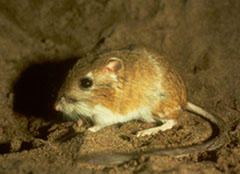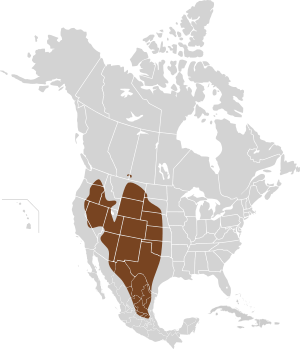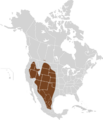Ord's kangaroo rat facts for kids
Quick facts for kids Ord's kangaroo rat |
|
|---|---|
 |
|
| Conservation status | |
| Scientific classification | |
| Genus: |
Dipodomys
|
| Species: |
ordii
|
 |
|
The Ord's kangaroo rat (Dipodomys ordii) is a small kangaroo rat that lives in western North America. You can find them from southern Canada all the way down to central Mexico. They are common in the Great Plains and the Great Basin areas.
These interesting animals have special hind feet for jumping, which are longer than 35 mm. Their total body length is usually over 240 mm. They have golden-brown fur on their backs and a white belly. Their long tails have a bushy tip and a white stripe on the side. A special feature is a fifth toe on their hind feet, which helps tell them apart from other kangaroo rats.
Even though they are common in the United States, the Ord's kangaroo rat population in Canada is considered endangered.
Contents
What's in a Name?
The scientific name for Ord's kangaroo rat is Dipodomys ordii. This name was given by Woodhouse in 1853. They belong to a family of animals called Heteromyidae, which includes other kangaroo rats and mice.
Where They Live
Ord's kangaroo rats live in many places across North America. Their home range stretches from southern Alberta and Saskatchewan in Canada, down to southern Hidalgo, Mexico. They also live from central Oregon and eastern California east to central Kansas and Oklahoma.
These rats prefer dry, open areas. They like sandy soils in places like deserts, grasslands, and shrublands. For example, in Nevada, they are found in desert scrub and areas with gravelly soil. In Utah, they like open areas with shrubs and grasses on sandy ground.
They need firm, but not too hard, soil to dig their burrows. If the soil is too hard, they can't dig their homes. In some areas, they live near prairie dog towns.
Their Homes and Habits
Ord's kangaroo rats are mostly active at night. They spend their days safely hidden in deep burrows. Males are often seen more often than females. They tend to be more active when it's cloudy, especially in winter. In warmer places like Texas, they are active all year. But in colder northern areas, they are rarely seen above ground in cold weather.
These rats dig shallow burrows in loose sand. You might find their burrows in sand dunes, riverbanks, or road cuts. Each rat usually has one main burrow. Small mounds of dirt often form outside the entrance. During the day, they plug the burrow opening with soil. This helps keep the temperature and humidity just right inside.
Life Cycle and Reproduction
The breeding season for Ord's kangaroo rats can change depending on where they live. Usually, they have one or two main breeding times each year. In many areas, some breeding happens all year long. More rainfall and plenty of food can lead to higher numbers of babies.
A female kangaroo rat is pregnant for about 28 to 32 days. They usually have one to six babies in a litter. In captivity, one female had up to five litters in a year. The oldest Ord's kangaroo rat ever recorded in captivity lived to be over 9 years old!
What They Eat
Ord's kangaroo rats mainly eat seeds and plants. They are also known as granivores (seed-eaters) and herbivores (plant-eaters). They enjoy seeds from grasses and other small plants, as well as green and dry vegetation. Sometimes, they will also eat insects and other small creatures.
For example, in Colorado, seeds make up most of their diet (about 74%). They also eat small plants, grasses, and insects. In Texas, they eat seeds from plants like sand paspalum, honey mesquite, and sunflowers.
They carry harvested seeds in special cheek pouches. They take these seeds back to their burrows to eat or to store them. They also hide seeds in many shallow holes in the ground. This hiding of seeds can sometimes help new plants grow! Kangaroo rats are very good at finding these buried seeds later.
These animals are well-suited for dry places. They get most of their water from the seeds and plants they eat. They will drink water if it's available, but they don't need to drink free water to survive.
Who Hunts Them?
Many animals hunt Ord's kangaroo rats. In areas like the Great Basin, their predators include coyotes, kit foxes, bobcats, and badgers. Birds of prey like long-eared owls, short-eared owls, great horned owls, burrowing owls, and various hawks also hunt them. Snakes, such as rattlesnakes and gopher snakes, are also predators.
In Idaho, Ord's kangaroo rat remains were found in up to 25% of prairie falcon nests. This shows they are an important food source for these birds.
Images for kids
![]() This article incorporates public domain material from the United States Department of Agriculture document "Dipodomys ordii".
This article incorporates public domain material from the United States Department of Agriculture document "Dipodomys ordii".
- View the kangaroo rat genome in Ensembl.
- View the dipOrd1 genome assembly in the UCSC Genome Browser.
See also
 In Spanish: Canguro-ratón para niños
In Spanish: Canguro-ratón para niños




